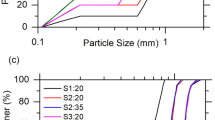Abstract
This paper uses tunnel stability factors to estimate the minimum supporting pressure required to maintain the stability of twin circular tunnels drive side-by-side in drained cohesive-frictional soil. Similar to the bearing capacity equation proposed by Terzaghi, the proposed method is based on the three stability factors (Fc, Fs and Fγ) that are functions of the soil internal friction angle and the tunnel depth ratio. Unlike the case of a single tunnel, the centre-to-centre distance between the tunnels appears as a new parameter that must be considered in twin tunnel stability. For various spacing ratios (S/D) between the tunnels, non-dimensional tunnel stability factors (Fc, Fs and Fγ) are established for various depth ratios (C/D) and soil internal friction angles (Ø) using two-dimensional finite element limit analysis. For practical suitability, the results are presented in the form of dimensionless stability charts with the actual tunnel stability factors closely bracketed from above and below using upper and lower bound methods. As an extra validation, the results are compared with available solutions reported in the literature.





















Similar content being viewed by others
References
Ghaboussi J, Ranken RE (1977) Interaction between two parallel tunnels. Int J Numer Anal Method Geomech 1(1):75–103
Keawsawasvong S, Ukritchon B (2017) Undrained stability of an active planar trapdoor in non-homogeneous clays with a linear increase of strength with depth. Comput Geotech 81:284–293
Krabbenhoft K, Lyamin AV, Hjiaj M, Sloan SW (2005) A new discontinuous upper bound limit analysis formulation. Int J Numer Methods Eng 63(7):1069–1088
Krabbenhøft K, Lyamin AV, Sloan SW (2007) Formulation and solution of some plasticity problems as conic programs. Int J Solids Struct 44(5):1533–1549
Lee CJ, Wu BR, Chen HT, Chiang KH (2006) Tunnel stability and arching effects during tunneling in soft clayey soil. Tunn Undergr Space Technol 21(2):119–132
Lu X, Zhou Y, Huang M, Li F (2017) Computation of the minimum limit support pressure for the shield tunnel face stability under seepage condition. Int J Civ Eng 15(6):849–863
Lyamin AV, Sloan SW (2000) Stability of a plane strain circular tunnel in a cohesive-frictional soil. In: Developments in theoretical geomechanics: proceedings of the Booker memorial symposium, Sydney, NSW, Australia, pp 139–154
Lyamin AV, Sloan SW (2002a) Lower bound limit analysis using non-linear programming. Int J Numer Methods Eng 55(5):573–611
Lyamin AV, Sloan SW (2002b) Upper bound limit analysis using linear finite elements and non-linear programming. Int J Numer Anal Methods Geomech 26(2):181–216
Lyamin AV, Jack DL, Sloan SW (2001) Collapse analysis of square tunnels in cohesive–frictional soils. In: Computational mechanics–new frontiers for the new millennium. Elsevier, pp 405–414
Mollon G, Dias D, Soubra AH (2011) Rotational failure mechanisms for the face stability analysis of tunnels driven by a pressurized shield. Int J Numer Anal Methods Geomech 35(12):1363–1388
OptumCE (2019) OptumG2. Copenhagen, Denmark: optum computational engineering. https://optumce.com/. Accessed 10 Aug 2019
Osman AS (2010) Stability of unlined twin tunnels in undrained clay. Tunn Undergr Space Technol 25(3):290–296
Sahoo JP, Kumar J (2013) Stability of long unsupported twin circular tunnels in soils. Tunn Undergr Space Technol 38:326–335
Shiau J, Al-Asadi F (2018) Revisiting Broms and Bennermarks original stability number for tunnel headings. Géotechn Lett 8(4):310–315
Shiau J, Al-Asadi F (2020a) Three-dimensional analysis of circular tunnel headings using Broms and Bennermarks original stability number. Int J Geomech 20(7):06020015
Shiau J, Al-Asadi F (2020b) Three-dimensional heading stability of twin circular tunnels. Geotech Geol Eng. https://doi.org/10.1007/s10706-020-01201-z
Shiau J, Al-Asadi F (2020c) Two-dimensional tunnel heading stability factors Fc, Fs and Fγ. Tunn Undergr Space Technol 97:103293
Shiau J, Al-Asadi F (2020d) Determination of critical tunnel heading pressures using stability factors. Comput Geotech 119:103345
Shiau J, Hassan MM (2019) Undrained stability of active and passive trapdoors. Geotech Res 7:40–48
Shiau J, Sams M (2019) Relating volume loss and greenfield settlement. Tunn Undergr Space Technol 83:145–152
Sloan SW (1988) Lower bound limit analysis using finite elements and linear programming. Int J Numer Anal Methods Geomech 12(1):61–77
Sloan SW (1989) Upper bound limit analysis using finite elements and linear programming. Int J Numer Anal Methods Geomech 13(3):263–282
Sloan SW (2013) Geotechnical stability analysis. Geotechnique 63(7):531–572
Ukritchon B, Keawsawasvong S (2017) Design equations for undrained stability of opening in underground walls. Tunn Undergr Space Technol 70:214–220
Vermeer PA, Ruse N, Marcher T (2002) Tunnel heading stability in drained ground. Felsbau 20(8):8–18
Wilson DW, Abbo AJ, Sloan SW, Lyamin AV (2014) Undrained stability of dual circular tunnels. Int J Geomech 14(1):69–79
Wilson DW, Abbo AJ, Sloan SW, Lyamin AV (2015) Undrained stability of dual square tunnels. Acta Geotech 10(5):665–682
Wu BR, Lee CJ (2003) Ground movements and collapse mechanisms induced by tunneling in clayey soil. Int J Phys Model Geotech 3(4):15–29
Xie J, Gunn MJ, Rahim A (2004) Collapse analysis for two parallel circular tunnels with different diameters in soil. In: Numerical models in geomechanics. CRC Press, Ottawa, Canada, pp 421–426
Zhou Y, Zhu Y, Wang S, Wang H, Wang Z (2019) Rotational failure mechanism for face stability of circular shield tunnels in frictional soils. Adv Civ Eng. https://doi.org/10.1155/2019/7167802
Author information
Authors and Affiliations
Corresponding author
Additional information
Publisher's Note
Springer Nature remains neutral with regard to jurisdictional claims in published maps and institutional affiliations.
Rights and permissions
About this article
Cite this article
Shiau, J., Al-Asadi, F. Twin Tunnels Stability Factors Fc, Fs and Fγ. Geotech Geol Eng 39, 335–345 (2021). https://doi.org/10.1007/s10706-020-01495-z
Received:
Accepted:
Published:
Issue Date:
DOI: https://doi.org/10.1007/s10706-020-01495-z




